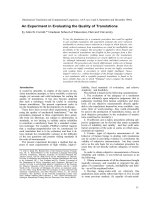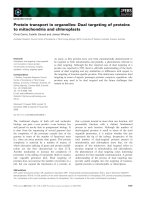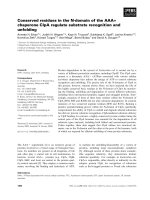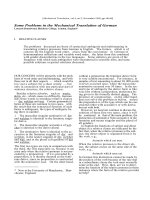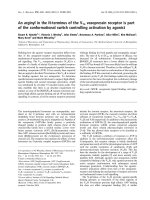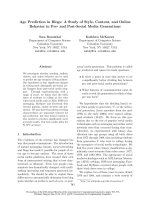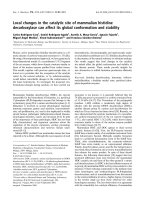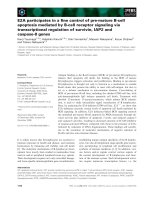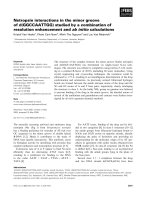báo cáo khoa học: "Allozyme variation in fourteen natural populations of Drosophila melanogaster collected from different regions of France" ppsx
Bạn đang xem bản rút gọn của tài liệu. Xem và tải ngay bản đầy đủ của tài liệu tại đây (454.08 KB, 10 trang )
Allozyme
variation
in
fourteen
natural
populations
of
Drosophila
melanogaster
collected
from
different
regions
of
France
Liliane
CHARLES-PALABOST,
Monique
LEHMANN
H. MERÇOT
Universite
de
Paris
VII,
Laboratoire
de
Génétique
des
Populations
Tour
42-32,
2,
place
lussieu,
F
75005
Paris
Summary
We
analyzed
allozyme
variation
of
6
gene
loci
in
14
populations
of
Drosophila
melanogaster
originating
from
different
regions
of
France
and
captured
from
fruits
of
the
localities
studied
(cellars
excluded).
With
respect
to
these
6
loci
the
populations
are
not
genetically
homogeneous.
Allelic
frequencies
at
the
Adh
locus
are
correlated
with
latitude
and
at
the
Est-6
with
the
kind
of
fruit
in
the
habitats.
In
spite
of
the
heterogeneity
of
these
14
new
populations,
the
comparison
between
them
and
15
other
French
populations
collected 9
or
10
years
ago,
in
cellars,
shows
a
remarkable
similarity
in
the
genetical
composition
of
4
loci
among
the
5
compared.
Thus,
the
different
habitats
of
these
populations
are
not
variable
enough
to
enable
much
genetic
differentiation.
Key
words :
Drosophila
melanogaster,
biochemical
polymorphism,
French
natural
popu-
lations.
Résumé
Polymorphisme
biochimique
de
quatorze
populations
naturelles
de
Drosophila
melanogaster,
capturées
dans
différentes
régions
de
France
Le
polymorphisme
de
6
locus
enzymatiques
a
été
analysé
dans
14
populations
de
Drosophila
melanogaster
réparties
du
Nord
au
Sud
de
la
France
et
capturées
sur
des
fruits
(caves
à
vin
exclues).
Un
cline
de
fréquences
avec
la
latitude
a
été
mis
en
évidence
au
locus
de
l’Adh.
Pour
l’Est-6,
les
fréquences
alléliques
semblent
dépendre
de
la
nature
du
fruit
de
piégeage.
Malgré
l’hétérogénéité
de
ces
14
nouvelles
populations,
la
comparaison
de
nos
résultats
avec
ceux
concernant
15
autres
populations
françaises,
capturées
dans
des
caves
à
vin
9
ou
10
ans
plus
tôt,
révèle
une
remarquable
similitude
dans
la
structure
génétique
de
4
des
5
locus
comparés.
Par
conséquent,
ces
populations
semblent
vivre
dans
des
habitats
assez
voisins
pour
ne
pas
entraîner
de
grandes
différenciations
génétiques.
Mots
clés :
Drosophila
melanogaster,
polymorphisme
biochimique,
populations
naturelles
françaises.
I.
Introduction
Generally,
allozyme
frequencies
in
natural
populations
of
Drosophila
melano-
gaster
within
the
same
geographical
area
differ
slightly
from
one
locality
to
another.
On
the
contrary,
when
collections
are
made
in
different
regions,
the
populations
show
a
large-scale
genetic
differentiation
(B
ERGER
,
1971 ;
DAVID,
1982 ;
G
IRARD
&
P
ALABOST
,
1976 ;
G
IRARD
Bt
aL,
1977 ;
JO
HNS
ON
&
S
CH
AFF
ER
,
1973 ;
O’B
RIEN
&
MacINTYRE,
1969 ;
S
INGH
et
al.,
1982).
The
first
French
populations
analyzed,
located
in
wine-cellars
of
the
Sa6ne
and
Rh6ne
valleys
(G
IRARD
&
P
ALABOST
,
1976 ;
G
IRARD
et
al.,
1977)
showed
that
the
frequencies
of
the
most
common
alleles
at
some
loci
(Est-C,
Est-6
and
a-Gpdh)
fluctuate
over
wide
limits ;
on
the
contrary,
at
other
loci
(Acph,
Adh
and
Odh),
allele
frequencies
are
very
similar
between
popu-
lations.
These
results
could
be
due,
either
to
the
particular
habitat
of
wine-cellars,
or
to
the
specific
geographical
localization
of
the
populations
examined.
Consequently,
for
a
better
understanding
of
biochemical
polymorphism
in
French
populations,
it
was
necessary
to
extend
the
analysis
to
populations
exclusively
collected
on
fruit,
from
the
North
to
the
South
of
France.
II.
Material
and
methods
A.
Collections
Wild
Drosophila
melanogaster
adults
were
collected
and
brought
to
the
labo-
ratory.
Flies
were
frozen
and
then
used
for
electrophoresis.
All
the
collections
were
made
during
the
annual
demographic
burst
of
the
species
(August
and
September).
B.
Populations
studied
Fourteen
populations
were
studied ;
their
origins
are
listed
below :
(1)
Tostes
near
Louviers ;
(2)
Le
Haras
du
Pin
near
Argentan ;
(3)
Sainte-Genevi6ve-des-Bois
near
Paris ;
(4)
Rann6e
near
Rennes ;
(5)
Nevez
near
Quimper ;
(6)
Chateaubriant ;
(7 )
M6n6tr6ol-sous-Sancerre
near
Sancerre ;
(8)
Bonnac-la-C6te
near
Limoges ;
(9)
Chessy-les-Mines
near
Villefranche-sur-Sa6ne ;
(10)
Beynost
near
Montluel ;
(11)
Le
Curtelod
near
Yenne ;
(12)
Allevard
near
Grenoble ;
(13)
Montauban ;
(14)
Tautavel
near Perpignan.
Figure
1
gives
the
geographical
localization
and
the
fruit
of
the
habitats.
C.
Electrophoresis
Allozyme
variation
was
studied
by
starch
gel
electrophoresis
using
P
OULIK
’S
discontinuous
buffer
system
(P
OULIK
,
1957).
Six
polymorphic
enzyme
loci
were
stu-
died,
according
to
the
techniques
described
in
A
YALA
et
al.
(1972) :
Acph
(acid
phosphatase ;
3-101.4),
Adh
(alcohol
dehydrogenase ;
2-50.1),
Est-C
(esterase-C ;
3-47.6),
Est-6
(esterase
6 ;
3-36.8),
!a-Gpdh
(a-glycerophosphate
dehydrogenase ;
2-20.5)
and
Pgm
(phosphoglucomutase ;
3-43.4).
Results
A.
Allelic
frequencies
and
comparison
between
the
populations
studied
Table
1
gives
for
each
population
the
number
of
genes
sampled
and
the
allelic
frequencies.
Homogeneity
between
populations
was
tested
using
a
xz
analysis
(no x
z
value
was
available
at
the
Acph
locus,
because
the
expected
allelic
numbers
of
the
S
allele
were
too
small).
Table
1
shows
that
some
geographical
heterogeneity
exists
in
the
frequency
distribution
of
the
alleles
at
every
locus,
i.e.,
local
differences
exist
at
highly
polymorphic
loci
(Est-6
and a-Gpdh)
as
is
indeed
the
case
at
other
loci.
B.
Comparison
between
our
results
and
those
previously
published
by
G
IRARD
&
P
ALABOST
(1976)
Since
neither
the
present
populations
nor
those
of
G
IRARD
&
P
ALABOST
(1976)
were
homogeneous,
it
was
not
possible
to
pool
them
in
each
group
for
a
comparison
using
the
X2
analysis.
Thus
the
comparison
was
carried
out
by
the
non-parametric
MANN-WHITNEY
U
test
on
the
common
allele
at
every
locus.
Table
2
gives
at
5
loci
(Pgm
was
not
studied
by
G
IRARD
&
P
ALABOST
)
the
number
of
populations,
the
mean
allelic
frequencies,
the
differences
between
the
averages
and
the
observed
U
values.
Except
for
Est-C,
the
gene
frequencies
among
the
5
loci
studied
are
uniform
between
populations
originating
from
the
Sa6ne
and
Rh6ne
Valleys
(wine-cellar
populations)
and
populations
more
widely
distributed
throughout
France
(fruit
populations).
Fruit
populations
analyzed
here
appear
to
be
characterized
only
by
a
higher
frequency
of
the
F
allele
at
the
esterase-C
locus.
C.
Correlation
between
gene
frequencies
and
latitude
Because
of
the
overlap
between
the
latitudinal
distribution
and
the
nature
of
the
fruit
in
our
populations
(fig.
1),
it
was
necessary
to
examine
the
latitudinal
relationships
of
allelic
frequencies
before
analyzing
the
role
of
the
fruit
in
the
differentiation
of
gene
frequencies.
Statistical
analysis
was
carried
out
by
SPEAR-
MAN’s
rank
correlation
test
on
the
common
allele
at
each
locus
(table
3).
A
correlation
between
F
allelic
frequency
and
latitude
is
observed
at
the
Adh
locus
(r
=
0.618).
This
latitudinal
relationship
is
well
known
over
small
distances
(G
ROSSMAN
Bt
al.,
1970 ;
PIPKIN
et
al.,
1973)
as
over
larger
ones
(A
NDERSON
,
1981 ;
J
OHNSON
&
S
CH
A
FFER
,
1973 ;
OAKE
SHO
TT
et
C
ll.,
1982).
The
5
other
coefficients
are
not
statistically
significant.
This
means
that
for
these
loci
(Acph,
Est-6,
Est-C,
a-Gpdh
and
Pgm)
a
comparison
between
the
populations,
grouped
according
to
the
kind
of
fruit
in
the
collecting
localities,
is
available.
Influence
of
the
type
of
fruit
in
the
population
studied
The
heterogeneity
demonstrated
in
table
1
might
be
due
to
the
kind
of
fruit
on
which
the
populations
had
been
collected.
So
we
have
divided
the
populations
into
3
groups :
apples,
plums
and
other
fruit
(varied
fruits
such
as
tomatoes,
melons,
peaches).
Comparison
between
the
populations
of
the
3
groups
was
carried
out
by
the
KRUSKAL-WALLIS
H
test
on
the
common
alleles
(tables
have
been
used
for
small
samples :
see
B
EYER
,
1981).
Table
4
gives
the
number
of
populations,
the
mean
allelic
frequencies
in
the
3
groups
and
the
H
values
obtained
after
comparison
between
these
groups.
A
survey
of
this
table
shows
significant
differences
between
the
3
groups
in
the
cases
of
Adh
and
Est-6
loci.
Since
for
Adh
a
correlation
with
latitude
was
mentioned
above
(table
3)
and
since
latitudinal
and
fruit
distributions
of
the
populations
studied
here
are
overlapping,
the
influence
of
fruit
on
the
gene
frequencies
can
be
taken
into
account
only
for
the
case
of
Est-6.
The
Est-6
s
allele
has
the
highest
frequency
(0.852 ± 0.020)
in
apple
populations,
the
smallest
in
plum
populations
(0.600
-±-
0.033)
and
an
intermediate
value
(0.755
± 0.025)
in
the
other
fruit
populations.
IV.
Discussion
and
conclusion
The
results
presented
here
provide
a
larger
description
of
the
biochemical
polymorphism
in
French
populations
of
Drosophila
melanogaster.
The
14
new
populations
originating
from
different
geographical
areas
(fig.
1)
show
a
more
or
less
high
level
of
variability
at
the
6
loci
studied
(table
1 ).
Curiously,
in
spite
of
this
heterogeneity,
the
patterns
of
the
allelic
frequency
distribution
are
similar
between
these
14
populations
and
those
previously
described
by
G
IRARD
&
P
ALABOST
in
1976
(table
2).
Because
all
of
G
IRARD
&
P
ALABOST
’S
populations
were
sampled
from
the
same
geographical
area,
we
can
note
that
the
extension
of
the
geographical
origin
of
the
populations
analyzed
has
not
provided
a
differentiation
in
the
allelic
frequency
distribution
for
four
enzymatic
loci
out
of
the
five
compared.
Moreover,
as
these
new
populations
have
been
captured
from
fruit,
it
appears
that
habitats
different
from
wine-cellars
have
not
induced
particular
patterns
of
allelic
frequencies.
Thus,
despite
the
small
number
of
loci
studied,
it
seems
that
temperate
habitats
in
France
do
not
vary
enough
to
provide
much
genetic
differentiation
in
the
case
of
enzymatic
polymorphism.
DAVID
(1982)
has
also
analyzed
5
other
French
populations
sampled
in
different
habitats
(wine-cellars,
fruit
or
urban
habitats);
4
of
them
were
located
in
the
same
geographical
area
as
those
of
G
IRARD
&
P
ALABOST
,
the
5
th
coming
from
Corsica.
At
the
4
loci
commonly
examined
by
DAVID
and
us
(presently
and
in
the
note
of
1976)
the
allelic
frequencies
are
similar.
D
AVID
’S
data
showed
that
F
allele
of
the
Adh
locus
was
favored
in
wine-cellar
populations.
With
our
14
new
populations,
no
significant
difference
between
wine-cellar
and
fruit
populations
is
observed
at
Adh.
Nevertheless,
in
regard
to
the
role
of
the
nutritive
resources
some
observations
are
noteworthy
for
the
fruit
populations.
The
3
kinds
of
fruit
(apples,
plums
and
others)
have
induced
a
genetic
differentiation
at
the
Adh
and
Est-6
loci
(table
4),
but
the
result
is
uncertain
for
Adh
because
a
latitudinal
cline
is
also
observed
(table
3).
In
the
case
of
Est-6
it
should
be
noted
that
the
S
allele
is
at
the
highest
frequency
in
apple
populations
(0.852
±
0.020)
and
at
the
lowest
in
plum
populations
(0.600
-!-
0.033).
As
can
be
seen
in
figure
1,
apple
populations
are
all
located
in
the
same
region
of
France
(North-West)
and
plum
populations
in
different
regions :
North-West
(population
6),
Center
(population
7),
and
South-East
(populations
9
and
10).
Thus,
because
the
resources
have
a
geographical
pattern,
further
studies
are
necessary
before
we
can
conclude
unambiguously
as
to
their
role
in
the
differentiation
of
allelic
frequencies
at
the
Est-6
locus.
Whatever
the
case,
this
result
can
argue
in
favor
of
the
influence
of
selection
on
the
Est-6
locus,
as
has
been
demonstrated
in
the
laboratory
(D
ANFORD
&
B
EARDMORE
,
1980)
and
in
natural
(OnxESHOTT et
al.,
1981)
populations.
Up
to
now,
despite
some
particular
local
situations,
the
different
studies
of
French
natural
populations
show
that
the
distributions
of
the
allelic
frequencies
at
most
loci
are
very
similar,
independently
of
geographical
situation
and
habitats.
However,
they
differ
from
populations
originating
in
other
continents
(O
AKESHOTT
et
al.,
1981, 1982,
1983).
Different
hypotheses
can
be
suggested
to
explain
this
result
relative
to
the
French
populations.
First,
if
migrations
are
important
between
the
numerous
wine-cellar
populations
(wine-cellars
are
certainly
the
most
common
habitat
of
Drosophila
melanogaster
in
France)
and
those
living
in
other
habitats
(such
as
orchards
and
kitchen-gardens),
this
could
explain
the
similarity
in
the
distributions
of
allozyme
frequencies.
Secondly,
the
selective
pressures
in
the
different
micro-
habitats
of
Drosophila
melanogaster
in
temperate
countries
like
France
would
not
be
sufficient
to
allow
a
great
between-populations
differentiation
at
the
enzymatic
polymorphism
level.
Acknowledgements
We
are
very
grateful
to
Professor
C.
PETIT
for
helpful
comments.
We
thank
Professor
D.
A
NX
O
LAB
EH
ERE
who
made
useful
suggestions.
We
thank
M.
BOU
LE
TREAU
,
A.
F
LEUR
IET
and
S.
R
ONSSERAY
for
collecting
the
populations.
This
study
was
carried
out
as
part
of
the
C.N.R.S.’s
ERA
406
and
GRECO
44
research
programs.
Received
July
10,
1984.
Accepted
December
12,
1984.
References
i
A
NDERSON
P.R.,
1981.
Geographic
clines
and
climatic
associations
of
Adh
and
a-Cpdh
gene
frequencies
in
Drosophila
melanogaster.
In :
Gissorr
J.B.,
O
AKESHOTT
J.G.
(ed.),
Genetic
studies
of
Drosophila
populations,
237-250.
Australian
National
University.
A
YALA
F.J.,
POW
ELL
J.R.,
T
RACEY
M.L.,
MOURA
O
C.A.,
P
EREZ
-S
ALAS
S.,
1972.
Enzyme
variability
in
the
Drosophila
willistoni
group.
IV.
Genic
variation
in
natural
populations
of
Drosophila
willistoni.
Genetics,
70,
113-139.
B
ERGER
M.,
1971.
A
temporal
survey
of
allelic
variation
in
natural
and
laboratory
populations
of
Drosophila
melanogaster.
Genetics,
67,
121-136.
B
EYER
W.H.,
1981.
Handbook
of
tables
for
probability
and
statistics,
2nd
edition.
Ed.
C.R.C.
press,
Inc.
Boca
Raton,
Florida,
U.S.A.
D
ANFORD
N.D.,
B
EARDMORE
J.A.,
1980.
Selection
at
the
esterase-6
locus
in
Drosophila
melanogaster
by
added
enzyme
substrates
in
the
culture
medium.
Genetica,
51,
171-178.
DAVID
J.,
1982.
Latitudinal
variability
of
Drosophila
melanogaster :
allozyme
frequencies
divergence
between
european
and
afrotropical
populations.
Biochem.
Genet.,
20,
747-761.
G
IRARD
P.,
P
ALABOST
L.,
1976.
Etude
du
polymorphisme
enzymatique
de
15
populations
naturelles
de
Drosophila
melanogaster.
Arch.
Zool.
Exp.
Gg
n.,
117,
41-55.
GIRARD
P.,
P
ALABO
ST
L.,
PETIT
C.,
1977.
Enzymatic
variation
at
seven
loci
in
nine
natural
populations
of
Drosophila
melanogaster.
Biochem.
Genet.,
15,
589-599.
G
ROSSMAN
A.I.,
K
ORENEVA
L.G.,
W
ITSKAYA
L.E.,
1970.
Variability
of
alcohol
dehydrogenase
(Adh)
locus
in
natural
populations
of
Drosophila
melanogaster.
Genetika
S.S.R.,
6,
91-96.
J
OHNSON
F.M.,
S
CHAFFER
H.E.,
1973.
Isozyme
variability
in
species
of the
genus
Drosophila.
VII.
Genotype
environment
relationships
in
populations
of
Drosophila
melanogaster
from
the
eastern
United
States.
Biochem.
Genet.,
10,
149-163.
O
AKESHOTT
J.G.,
CHAMBERS
G.K.,
G
IBSON
J.B.,
WI
LLC
O
CK
s
D.A.,
1981.
Latitudinal
re-
lationships
of
esterase-6
and
phosphoglucomutase
gene
frequencies
in
Drosophila
melanogaster.
Heredity,
47,
385-396.
OA
KESHOTT
J.G.,
GIBSON
J.B.,
ANDERSON
P.R.,
KNIBB
W.R.,
ANDERSON
D.G.,
CHAMBERS
G.K.,
1982.
Alcohol
dehydrogenase
and
glycerol-3-phosphate
dehydrogenase
clines
in
Dro-
sophila
melanogaster
on
different
continents.
Evolution,
36,
86-96.
O
AKESH
O
TT
J.G.,
G
IBSON
J.B.,
W
ILLCOC
KS
D.A.,
CHAMBERS
G.K.,
1983.
Latitudinal
variation
in
octanol
dehydrogenase
and
acid
phosphatase
allele
frequencies
in
Drosophila
melanogaster.
Theor.
Appl.
Genet.,
65,
191-196.
O’
BRIEN
S.J.,
MA
CI
NTYRE
R.J.,
1969.
An
analysis
of
gene-enzyme
variability
in
natural
populations
of
Drosophila
melanogaster
and
Drosophila
simulans.
Am.
Nat.,
103,
97-113.
PIPKIN
S.B.,
RHODES
C.,
W
ILLIAMS
N.,
1973.
Influence
of
temperature
on
Drosophila
alcohol
dehydrogenase
polymorphism.
J.
Hered.,
64,
181-185.
PouLIK
M.D.,
1957.
Starch
gel
electrophoresis
in
a
discontinuous
system
of
buffer.
Nature,
180,
1477-1479.
S
INGH
R.S.,
H
ICKEY
D.R.,
DAVID
J.,
1982.
Genetic
differentiation
between
geographically
distant
populations
of
Drosophila
melanogaster.
Genetics,
101,
235-256.
